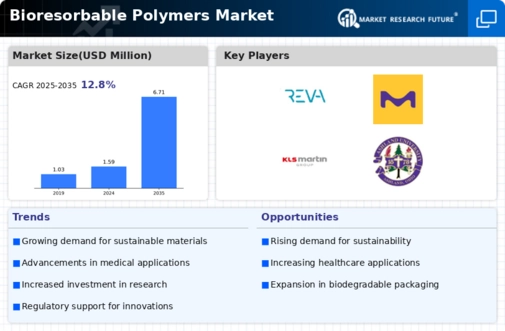Market Trends
Key Emerging Trends in the Bioresorbable Polymers Market
Expeditious Advancements in 3D Printing Technologies Propel Bioresorbable Polymers Market
The bioresorbable polymers market is witnessing a surge in growth propelled by the rapid evolution of 3D printing technologies. In the realm of medical devices, such as fixation plates, screws, sutures, and scaffolds for tissue engineering, bioresorbable polymers take center stage. Over the past decade, the adoption of 3D printing for clinical and research purposes in medicine has seen a substantial uptick, offering a paradigm shift in manufacturing possibilities. The technology's capability to craft intricate porous geometries, vital for scaffolds but unattainable through traditional production methods, underscores its transformative potential.
In the medical and dental industry, 3D printing technology emerges as a game-changer for creating and optimizing medical device designs. The advent of low-cost rapid prototyping has kindled increased interest and flexibility among medical device manufacturers in designing novel products, thereby expediting the introduction of new medical devices to the market. Notably, prosthetics and implants can be produced more affordably than through traditional technologies, as 3D printing not only reduces costs but also accelerates the production timeline.
Although the medical sector constitutes a fraction of the broader additive manufacturing market, it continually pioneers innovative applications for 3D printing technology. Patients are already benefiting from personalized 3D-printed implants and prostheses tailored to their unique anatomies. Cases of newborns with rare tracheal abnormalities have been successfully addressed through 3D printing, exemplifying its life-saving potential. The landscape of joint replacements and bone restoration therapies is undergoing transformation due to additive manufacturing techniques, enabling a degree of customization previously unattainable. Polylactic acid (PLA) stands out as the most frequently utilized bioresorbable polymer in biomedical applications within 3D printing, particularly in orthosis and prosthesis. The medical sector is witnessing groundbreaking innovations, ranging from 3D-printed human body implants to the development of cardiac tissues, all leveraging polymers for prototyping or implant production.
According to Statista, the global market for 3D printing products and services is poised for robust growth, projected to reach USD 37.2 billion by 2026, as depicted in the graph below. This foretells a promising trajectory for the rapid advancement of 3D printing technology, signifying lucrative opportunities for the continued expansion of the bioresorbable polymers market. As 3D printing becomes increasingly integral to the medical landscape, the symbiotic relationship between this technology and bioresorbable polymers is set to redefine the possibilities in healthcare applications, offering tailored solutions for patients and unlocking new dimensions of innovation.







Leave a Comment